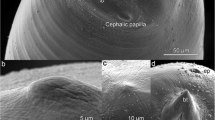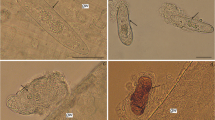Abstract
The morphology of the rediae of Echinostoma paraensei obtained from Lymnaea columella was studied using light, scanning and transmission electron microscopy. The measurements of the mature rediae differ from those described originally, and the taxonomic importance of the ambulatory buds and papilliform process is discussed. Uniciliated papillae were observed in the mouth region. The birth papilla is a bulb-like structure, well defined at the anterior end of the body of the rediae, which opens through a split. There are no microvilli in the tegument surface of the larvae, but numerous tegumental folds, varying according to the contraction of the body of the rediae. The outer syncytial layer is located on a thick basal lamina below which the circular and the longitudinal muscle fiber layers are located.



Similar content being viewed by others
References
Amato JFR, Boeger WAP, Amato SB (1991) Protocolos para laboratório—Coleta e processamento de parasitos de pescado. Imprensa Universitária, UFRRJ, Seropédica, Rio de Janeiro
Fernandes MC (1949) Métodos Escolhidos de Técnica Microscópica, 2nd edn. Imprensa Nacional, Rio de Janeiro
Fried B, Awatramani R (1992) Light and scanning electron microscopical observations of the daughter rediae of Echinostoma trivolvis (Trematoda). Parasitol Res 78:257–259
Fujino T, Takahashi T, Fried B (1995) A Comparison of Echinostoma trivolvis and E. caproni using random amplified polymorphic DNA analysis. J Helminthol 69:263–264
Haseeb MA, Eveland LK (2000) Human echinostomiasis: mechanisms of pathogenesis and host resistance. In: Fried B, Graczyk TK (eds) Echinostomes as experimental models for biological research. Kluwer Academic, Dordrecht, pp 83–98
Hoskin GP (1975) Light and electron microscopy of the host-parasite interface and histopathology of Nassarius obsoletus infected with rediae of Himashtla quissetensis. Ann N Y Acad Sci 266:497–512
Hoskin GP, Cheng TC (1973) Dehydrogenase activity in the rediae of Himashtla quissetensis (Trematoda) as an indicator of substrate utilization. Comp Biochem Physiol 47B:361–366.
Hoskin GP, Cheng TC (1974) Himashtla quissetensis: uptake and utilization of glucose by rediae as determined by autoradiography and respirometry. Exp Parasitol 468:821–829.
Irwin SWB, Threadgold LT, Howard NM (1978) Cryptocotyle lingua (Creplin) (Digenea: Heterphyidae): observations on the morphology of the rediae, with special reference to the birth papilla and release of cercariae. Parasitology 76:193–199
Kanev I (1994) Life-cycle, delimitation and redescription of Echinostoma revolutum (Fröelich, 1802) (Trematoda: Echinostomatidae). Syst Parasitol 28:125–144
Kanev I, Fried B, Dimitrov V, Radev V (1995) Redescription of Echinostoma trivolvis (Cort, 1914) (Trematoda: Echinostomatidae) with a discussion of its identity and characteristics. Syst Parasitol 32:61–70
Kanev I, Radev V, Sterner M, Fried B (2000) An overview of the biology of echinostomes. In: Fried B, Graczyk TK (eds) Echinostomes as experimental models for biological research. Kluwer Academic, Dordrecht, pp 1–29
Koie M (1971) On the histochemistry and ultrastructure of the rediae of Neophasis lageniformis (Lebour, 1910) (Trematoda: Acanthocolpidae). Ophelia 9:113–143
Koie M (1975) On the morphology and life history of Ophecoma bacillaris (Molin, 1859) Looss, 1907 (Trematoda, Lepocreadiidae). Ophelia 13:63–86
Koie M (1985) On the morphology and life history of Lepidapedon elongatum (Lebour, 1908) Nicoll, 1910 (Trematoda, Lepocreadiidae). Ophelia 24:135–153
Koie M (1987) Scanning electron microscopy of rediae, cercariae, metacercariae and adults of Mesoprchis denticulatus (Rudolphi, 1802) (Trematoda, Echinostomatidae). Parasitol Res73:50–56
Koie M, Nansen P, Christensen NO (1977) Stereoscan studies of rediae, cercariae, cysts, excysted metacercariae and migratory stages of Fasciola hepatica. Z Parasitenkd 54:289–297
Krejci KG, Fried B (1994) Light and scanning electron microscopic observations of the eggs, daughter rediae, cercariae, and encysted metacercariae of Echinostoma trivolvis and E. caproni. Parasitol Res 80:42–47
Krupa PL, Cosineau GH, Bal AK (1968) Ultrastructural and histochemical observations on the body wall of Cryptocotyle lingua rediae (Trematoda). J Parasitol 54:900–908
Lie KJ, Basch PF (1967) The life history of Echinostoma paraesei sp. n. (Trematoda,: Echinostomatidae). J Parasitol 53:1192–1199
Lim HK, Heyneman D (1972) Intramolluscan inter-trematode antagonism: a review of factors influencing the host-parasite system and its possible role in biological control. Adv Parasitol 10:191–268
Maldonado AJr, Loker ES, Morgan JAT, Rey L, Janfredi RM (2001a) Description of the adult worms of a new Brazilian isolate of Echinostoma paraensei (Platyhelminthes: Digenea) from its natural vertebrate host Nectomys squamipes by light and scanning electron microscopy and molecular anlysis. Parastol Res 87:840–848
Maldonado AJr, Vieira GO, Garcia JS, Rey L, Lanfredi RM (2001b) Biological aspects of a new isolate of Echinostoma paraensei (Trematoda: Echinostomatidae): susceptibility of sympatric snails and natural vertebrate host. Parasitol Res 87:853–859
Moore MN, Halton DW (1975) A histochemical study of the redia and cercariae of Fasciola hepatica (Trematoda). Z Parasitenkd 47:45–54
Morgan JAT, Blair D (1998) Relative merits of nuclear ribosomal internal transcribed spacers and mitochondrial CO1 and ND1 genes for distinguishing among Echinostoma species (Trematoda). Parasitology 116:289–297
Nasir P (1962) Further observations on the life cycle of Echinostoma nudicaudatum Nasir, 1960 (Echinostomatidae: Trematoda). Proc Helminthol Soc Wash 29:115–127
Nollen PM (1992) A comparison of the surface features of Philophtalmus megalurus and Philophtalmus gralli rediae by scanning and electron microscopy. J Parasitol 78:360–364
Page MR, Nadakavukaren MJ, Huizinga HW (1980) Ribeirioia marini: surface ultrastructure of rediae, cercariae, and adult. Int J Parasitol 10:5–12
Petrie JL, Burg III EF, Can G (1996) Molecular characterization of Echinostoma caproni and E. paraensei by random amplification of polymorphic DNA (RAPD) analysis. J Parasitol 82:360–362
Reader TAJ (1972) Ultrastructural and cytochemical observations on the body wall of the redia of Sphaeridiotrema globulus (Rudolphi, 1819). Parasitology 65:537–546
Rees G (1966) Light and electron microscope studies of the rediae of Parorchis acanthus Nicoll. Parasitology 56:589–602
Rees G (1971) The ultrastructure of the epidermis of the rediae and cercaria of Parorchis acanthus Nicoll. A study by scanning and transmission electron microscopy. Parasitology 62:479–488
Rees GF (1980) Surface ultrastructure of the redia of Parorchis acanthus, Nicoll (Digenea: Philophtalmidae). Z Parasitenkd 63:36–46
Richards RJ (1969) Qualitative and quantitative estimations of the free amino acids in the healthy and parasitized digestive gland and gonad of Littorina saxatilis tenebrosa (Mont.) and in the daughter sporocysts of Microphallus hygmaeus (Levinsen, 1881) and Microphallus similis (Jagerrskfold, 1900) (Trematoda: Microphallidae). Comp Biochem Physiol 31:655–665
Sloss B, Meece J, Romano N, Nollen P (1995) The genetic relationship between Echinostoma caproni, Echinostoma paraensei, and Echinostoma trivolvis as determined by electrophoresis. J Helminthol 69:243–246
Valkuonova J, Zdarska Z, Nasincova V (1989) Ultrastructural observations on the redia of Echinostoma trivolvis (Fröelich, 1802). Folia Parasitol 36:25–30
Watts SDM (1970) The amino acid requirements of the rediae of Cryptocotyle lingua and Himashtla leptosoma and of the sporocyst of Cercaria emasculans Pelseneer, 1900. Parasitology 61:491–497
Zdarska Z, Nasincova V, Valkuonova J (1988) Multiciliate sensory endings in the redia of Echinostoma revolutum (Trematoda, Echinostomatidae). Folia Parasitol 35:17–20
Acknowledgements
We thank Mr. Sebastião da Cruz, Laboratório de Ultraestrutura Celular Hertha Meyer, UFRJ, RJ, Brazil, for technical support in electron microscopy and Miss Aleksandra de Oliveira Menezes, Laboratório de Biologia de Helmintos Otto Wucherer, Universidade Federal do Rio de Janeiro, for valuable suggestions. This work was supported by: Conselho Nacional de Desenvolvimento Científico e Tecnológico, Fundação Carlos Chagas Filho de Amparo a Pesquisa do Estado do Rio de Janeiro, Fundação Universitária José Bonifácio and Programa de Núcleos de Excelência.
Author information
Authors and Affiliations
Corresponding author
Rights and permissions
About this article
Cite this article
Pinheiro, J., Maldonado Júnior, A., Attias, M. et al. Morphology of the rediae of Echinostoma paraensei (Trematoda: Echinostomatidae) from its intermediate host Lymnaea columella (Mollusca, Gastropoda). Parasitol Res 93, 171–177 (2004). https://doi.org/10.1007/s00436-004-1110-z
Received:
Accepted:
Published:
Issue Date:
DOI: https://doi.org/10.1007/s00436-004-1110-z




